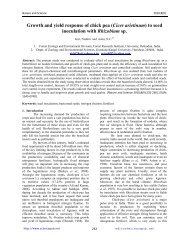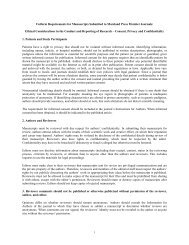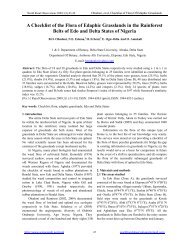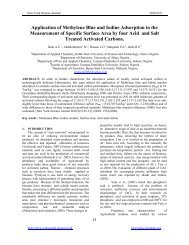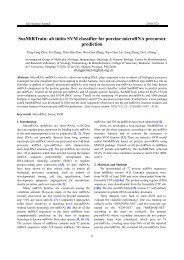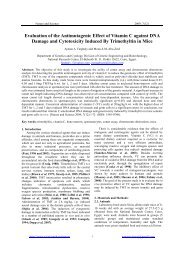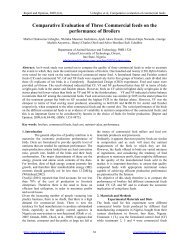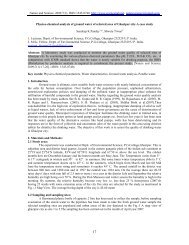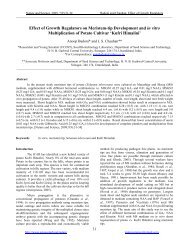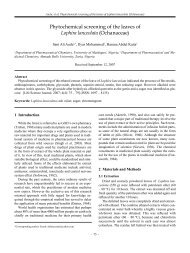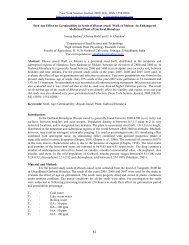Ecological, Social and Commercial Role of Lichens in India with ...
Ecological, Social and Commercial Role of Lichens in India with ...
Ecological, Social and Commercial Role of Lichens in India with ...
You also want an ePaper? Increase the reach of your titles
YUMPU automatically turns print PDFs into web optimized ePapers that Google loves.
Acdemia Arena 2010, Supplement 0201<br />
http://www.sciencepub.net<br />
More than 100 twig samples <strong>of</strong> each species <strong>of</strong> Oak were r<strong>and</strong>omly collected from three<br />
altitud<strong>in</strong>al gradient dur<strong>in</strong>g months <strong>of</strong> October-November 2006. The altitude between 1500-2000m<br />
exhibit growth <strong>of</strong> Quercus leucotrichophora (White Oak), followed by 2000-2500m <strong>of</strong> Q.<br />
floribunda (Green Oak) <strong>and</strong> above 2,500m <strong>of</strong> Quercus semecarpifolia (Brown Oak) respectively.<br />
The collected twigs were categorized <strong>in</strong> five diameter size classes <strong>of</strong> 0-1cm, 1.1-2.0cm, 2.1-3.0cm,<br />
3.1-4.0cm <strong>and</strong> more than 4.1cm.<br />
The diameters <strong>of</strong> 20 twig samples <strong>of</strong> each class were measured. Individuals <strong>of</strong> macrolichen<br />
species grow<strong>in</strong>g on each twig were counted.<br />
Results <strong>and</strong> Discussion<br />
All the three oak trees exhibit luxuriant growth <strong>of</strong> Parmelioid lichens <strong>and</strong> members <strong>of</strong> lichen<br />
family Physciaceae together <strong>with</strong> fruticose lichen <strong>of</strong> genera Ramal<strong>in</strong>a <strong>and</strong> Usnea (Table 1-3).<br />
a) <strong>Lichens</strong> associated <strong>with</strong> twigs <strong>of</strong> Q. leucotrichophora (altitude between 1,500-2,000 m):<br />
The twigs <strong>of</strong> Q. leucotrichophora bear only 12 species <strong>of</strong> lichens (Table 1). The twigs <strong>of</strong><br />
diameter 3.1-4.0cm <strong>and</strong> more than 4.1cm bear 82 <strong>and</strong> 27 <strong>in</strong>dividuals <strong>of</strong> lichens.<br />
Parmotrema wallichiana exhibits occurrence on twigs <strong>of</strong> all five diameter classes twigs but<br />
the diameter class 3.1-4.0 cm bears the maximum <strong>in</strong>dividuals P. wallichiana followed by<br />
twig classes 0-1.0 cm, 1.1-2.0cm, 2.1-3.0 <strong>and</strong> more than 4.1cm. Parmelioid lichens<br />
dom<strong>in</strong>ate the Q. leucotrichophora twigs than Usneoid lichens.<br />
b) <strong>Lichens</strong> associated <strong>with</strong> twigs <strong>of</strong> Q. floribunda (altitude between 2,000 m-2,500 m): The<br />
twigs <strong>of</strong> Q. floribunda bear 16 species <strong>of</strong> lichens (Table 2). The twigs <strong>of</strong> diameter more than<br />
4.1cm exhibit occurrence 71 <strong>in</strong>dividuals. E. nepalense, dom<strong>in</strong>ates on all the five diameter<br />
class <strong>of</strong> twigs. But the diameter class 3.1-4.0cm <strong>and</strong> 1.1-2.0 cm bear similar number <strong>of</strong><br />
<strong>in</strong>dividuals. The fruticose lichens exhibit higher association <strong>with</strong> Q. floribunda twigs than<br />
the foliose form.<br />
c) <strong>Lichens</strong> associated <strong>with</strong> twigs <strong>of</strong> Q. semecarpifolia (altitude above 2,500 m): Q.<br />
semecarpifolia twigs bear 29 species <strong>of</strong> lichens (Table 3). The twigs <strong>of</strong> diameter class more<br />
than 4.1cm bear 148 <strong>in</strong>dividuals <strong>of</strong> lichens. E. nepalense exhibits its occurrence all the five<br />
diameter classes <strong>of</strong> twigs. The twig class 3.1-4.0cm bears the maximum <strong>in</strong>dividuals<br />
followed by twigs <strong>of</strong> 2.1-3.0cm <strong>and</strong> 1.1-2.0cm. The diameter class <strong>of</strong> 0-1.0cm towards the<br />
81






